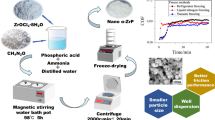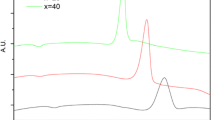Abstract
Nanoparticles in solution offer unique electrical, mechanical and thermal properties due to their physical presence and interaction with the state of dispersion. This work is aimed to study the effects of hydroxyapatite (HA) nanoparticles on the behavior of devitrification and recrystallization of glycerol (60% w/w) and PEG-600 (50% w/w) solutions during warming. HA nanoparticles of different sizes (20, 40, 60 nm) and concentrations (0.1%, 0.5%, w/w) were incorporated into solutions, and were studied by calorimetric analysis coupled with cryomicroscopy. The presence of HA nanoparticles has little effect on the devitrification end temperatures, but affects the devitrification onset temperatures of glycerol and PEG-600 solutions. The investigation with the cryomicroscope observed that the ice morphologies of glycerol and PEG-600 solutions are dendritic and spheric respectively. The ice fraction of glycerol solution containing 0.1% HA with the size of 60 nm decreased to 2/5 of that of the solution without nanoparticles at −45°C. The ice fractions of PEG-600 solutions increased significantly between −64°C and −54°C, and the ice fraction of PEG-600 solution without nanoparticles increased by 92% within the temperature range. The findings have significant implications for biomaterial cryopreservation, cryosurgery, and food manufacturing. The complexity of ice crystal growth kinetics in nanoparticle-containing solutions awaits further study.
Similar content being viewed by others
References
Gao D, Critser J K. Mechanisms of cryoinjury in living cells. ILAR J, 2000, 41: 18796
Pegg D E. The relevance of ice crystal formation for the cryopreservation of tissues and organs. Cryobiology, 2010, 60: S36–S44
Kiani H, Sun D W. Water crystallization and its importance to freezing of foods: A review. Trends Food Sci Technol, 2011, 22: 407–426
Syamaladevi R M, Manahiloh K N, Muhunthan B. Understanding the influence of state/phase transitions on ice recrystallization in atlantic salmon (salmo salar) during frozen storage. Food Biophys, 2012, 7: 57–71
Yu T H, Liu J, Zhou Y X. Selective freezing of target biological tissues after injection of solutions with specific thermal properties. Cryobiology, 2005, 50: 174–182
Gage A A, Baust J G. Cryosurgery-A review of recent advances and current issues. Cryoletters, 2002, 23: 69–78
Mazur P, Seki S. Survival of mouse oocytes after being cooled in a vitrification solution to −196°C at 95°C to 70,000°C/min and warmed at 610°C to 118,000°C/min: A new paradigm for cryopreservation by vitrification. Cryobiology, 2011, 62: 1–7
Seki S, Mazur P. Ultra-rapid warming yields high survival of mouse oocytes cooled to 196°C in dilutions of a standard vitrification solution. PloS One, 2012, 7: e36058–e36058
Vigier G. Cubic and hexagonal ice formation in water-glycerol mixture (50% w/w). J Cryst Growth, 1987, 84: 309–315
Diller K R, Cravalho E G. A cryomicroscope for the study of freezing and thawing processes in biological cells. Cryobiology, 1971, 7: 191–199
Steponkus P L, Dowgert M F, Ferguson J R, et al. Cryomicroscopy of isolated plant protoplasts. Cryobiology, 1984, 21: 209–233
Steponkus P L, Stout D E. Freezing-induced electrical transients and cryoinjury. Cryoletters, 1984, 5: 343–348
Goff H D. Glass transitions in frozen sucrose solutions are influenced by solute inclusions within ice crystals. Thermochimica Acta, 2003, 399: 43–55
Methl P. Cryomicroscopy as a support technique for calorimetric measurements by DSC for the study of the kinetic-parameters of crystallization in aqueous-solutions. Part 1. Nucleation in the water-1,2-propanediol system. Thermochim Acta, 1992, 203: 475–492
Methl P. Crystallization in glass-forming aqueous solutions during warming: Numerical construction of non-isothermal DSC thermocurves during warming from isothermal data. Application to 42.5% w/w 1,2-propanediol/water. Thermochim Acta, 1993, 223: 157–165
Mehl P. Isothermal and non-isothermal crystallization during warming in aqueous solutions of 1,3-butanediol: Comparison of calorimetry and cryomicroscopy. Thermochim Acta, 1989, 155: 187–202
Mehl P. Experimental dissection of devitrification in aqueous solu tions of 1,3-butanediol. Cryobiology, 1990, 27: 378–400
Schmidt G, Malwitz M M. Properties of polymer-nanoparticle composites. Curr Opin Colloid Interface Sci, 2003, 8: 103–108
Hao B T, Liu B L, Rong S J. Effect of HA nanoparticles on thermodynamic parameters of cryoprotective agents. Cryobiology, 2009, 59: 409–410
Han X, Ma H B, Wilson C. Effects of nanoparticles on the nucleation and devitrification temperatures of polyol cryoprotectant solutions. Microfluidics Nanofluidics, 2008, 16: 357–361
Hagiwara T, Hartel R W, Matsukawa S. Relationship between recrystallization rate of ice crystals in sugar solutions and water mobility in freeze-concentrated matrix. Food Biophys, 2006, 1: 74–82
Seki S, Mazur P. The dominance of warming rate over cooling rate in the survival of mouse oocytes subjected to a vitrification procedure. Cryobiology, 2009, 59: 75–82
Gonda T, Sei T. The inhibitory growth mechanism of saccharides on the growth of ice crystals from aqueous solutions. Prog Cryst Growth Ch, 2005, 51: 70–80
Muldrew K, Rewcastle J, Donnelly B J. Flounder antifreeze peptides increase the efficacy of cryosurgery. Cryobiology, 2001, 42: 182–189
Petzold G, Aguilera J M. Ice morphology: Fundamentals and technological applications in foods. Food Biophys, 2009, 4: 378–396
Author information
Authors and Affiliations
Corresponding author
Rights and permissions
About this article
Cite this article
Lv, F., Liu, B., Li, W. et al. Effects of nanoparticles on devitrification and recrystallization of aqueous glycerol and PEG-600 solutions. Sci. China Technol. Sci. 57, 264–269 (2014). https://doi.org/10.1007/s11431-014-5457-9
Received:
Accepted:
Published:
Issue Date:
DOI: https://doi.org/10.1007/s11431-014-5457-9




